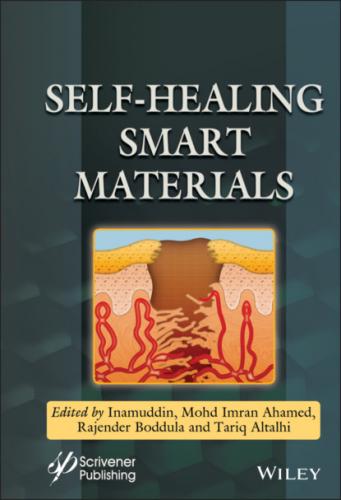Self-Healing Smart Materials. Группа авторов
Macro Lett., 8, 506, 2019.
62. Lendlein, A. and Kelch, S., Shape-memory polymers. Angew. Chem. Int. Edit., 41, 2034, 2002.
63. Bilici, C., Can, V., Nöchel, U., Behl, M., Lendlein, A., Okay, O., Meltprocessable shape-memory hydrogels with self-healing ability of high mechanical strength. Macromolecules, 49, 7442, 2016.
64. Lendlein, A., Jiang, H.Y., Junger, O., Langer, R., Light-induced shape-memory polymers. Nature, 434, 879, 2005.
65. Okay, O., Semicrystalline physical hydrogels with shape-memory and self-healing properties. J. Mater. Chem. B, 7, 1581, 2019.
66. Kurt, B., Gulyuz, U., Demir, D.D., Okay, O., High-strength semi-crystalline hydrogels with self-healing and shape memory functions. Eur. Polym. J., 81, 12, 2016.
67. Kimura, H., Matsumoto, A., Hasegawa, K., Ohtsuka, K., Fukuda, A., Epoxy resin cured by bisphenol a based benzoxazine. J. Appl. Polym. Sci., 68, 1903, 1998.
68. Rao, B.S., Reddy, K.R., Pathak, S.K., Pasala, A., Benzoxazine-epoxy copolymers: Effect of molecular weight and crosslinking on thermal and viscoelastic properties. Polym. Int., 54, 1371, 2005.
69. Liu, Y., Gao, S., Gong, X., Xue, Q., Lu, Z., Benzoxazine-epoxy thermosets with smectic phase structures for high thermal conductive materials, Liq. Cryst., 46, 11, 1686−1695, 2019.
70. Rimdusit, S. and Ishida, H., Synergism and multiple mechanical relaxations observed in ternary systems based on benzoxazine, epoxy, and phenolic resins. J. Polym. Sci. Part B: Polym. Phys., 38, 1687, 2000.
71. Sarawut, R., Montha, L., Kasinee, H., Pornnapa, K., Isala, D., Shape memory polymers from benzoxazine-modified epoxy. Smart Mater. Struct., 22, 075033, 2013.
72. Schäfer, H., Hartwig, A., Koschek, K., The nature of bonding matters: Benzoxazine based shape memory polymers. Polymer, 135, 285, 2018. 73. Schäfer, H. and Koschek, K., Effect of poly(-caprolactone) in polybenzoxazine blends and respective copolymers on morphology and mechanical properties. Eur. Polym. J., 108, 582, 2018.
74. Arslan, M., Kiskan, B., Yagci, Y., Benzoxazine-based thermoset with autonomous self-healing and shape recovery. Macromolecules, 51, 10095, 2018.
75. Sudo, A., Hirayama, S., Endo, T., Highly efficient catalysts-acetylacetonato complexes of transition metals in the 4th period for ring-opening polymerization of 1,3-benzoxazine. J. Polym. Sci. Part A: Polym. Chem., 48, 479, 2010.
76. Arslan, M., Kiskan, B., Yagci, Y., Ring-opening polymerization of 1,3-benzoxazines via borane catalyst. Polymers, 10, 239, 2018.
77. Low, H.Y. and Ishida, H., Improved thermal stability of polybenzoxazines by transition metals. Polym. Degrad. Stabil., 91, 805, 2006.
78. Chaisuwan, T., Komalwanich, T., Luangsukrerk, S., Wongkasemjit, S., Removal of heavy metals from model wastewater by using polybenzoxazine aerogel. Desalination, 256, 108, 2010.
79. Aydogan, C., Kiskan, B., Hacioglu, S.O., Toppare, L., Yagci, Y., Electrochemical manipulation of adhesion strength of polybenzoxazines on metal surfaces: From strong adhesion to dismantling. RSC Adv., 4, 27545, 2014.
80. Akay, S., Kayan, B., Kalderis, D., Arslan, M., Yagci, Y., Kiskan, B., Poly(benzoxazine-co-sulfur): An efficient sorbent for mercury removal from aqueous solution. J. Appl. Polym. Sci., 134, 45306, 2017.
81. Taskin, O., Kiskan, B., Aksu, A., Balkis, N., Weber, J., Yagci, Y., Polybenzoxazine: A powerful tool for removal of mercury salts from water. Chem.—Eur. J., 20, 10953, 2014.
82. Balkenende, D.W.R., Coulibaly, S., Balog, S., Simon, Y.C., Fiore, G.L., Weder, C., Mechanochemistry with metallosupramolecular polymers. J. Am. Chem. Soc., 136, 10493, 2014.
83. Bode, S., Bose, R.K., Matthes, S., Ehrhardt, M., Seifert, A., Schacher, F.H., Paulus, R.M., Stumpf, S., Sandmann, B., Vitz, J. et al., Self-healing metallopolymers based on cadmium bis(terpyridine) complex containing polymer networks. Polym. Chem., 4, 4966, 2013.
84. Bode, S., Zedler, L., Schacher, F.H., Dietzek, B., Schmitt, M., Popp, J., Hager, M.D., Schubert, U.S., Self-healing polymer coatings based on crosslinked metallosupramolecular copolymers. Adv. Mater., 25, 1634, 2013.
85. Sandmann, B., Happ, B., Kupfer, S., Schacher, F.H., Hager, M.D., Schubert, U.S., The self-healing potential of triazole-pyridine-based metallopolymers. Macromol. Rapid Commun., 36, 604, 2014.
86. Zheng, P., Arantes, G.M., Field, M.J., Li, H., Force-induced chemical reactions on the metal centre in a single metalloprotein molecule. Nat. Commun., 6, 7569, 2015.
87. Li, C.-H., Wang, C., Keplinger, C., Zuo, J.-L., Jin, L., Sun, Y., Zheng, P., Cao, Y., Lissel, F., Linder, C. et al., A highly stretchable autonomous self-healing elastomer. Nat. Chem., 8, 618, 2016.
*Corresponding author: [email protected]
3
Self-Healable Elastomers
Mariajose Cova Sánchez 1 , Daniela Belén García 2 , Mariano Martin Escobar 2,3 * and Marcela Mansilla 3
1 Departamento de Asistencia a la Industria del Caucho, Instituto Nacional de Tecnología Industrial, Buenos Aires, Argentina
2 Departamento de Diseño de materiales, Instituto Nacional de Tecnología Industrial, Buenos Aires, Argentina
3 INTI, CONICET, Departamento de Diseño de Materiales, Buenos Aires, Argentina
Abstract
The chapter is divided in three sections: the first one is an introduction about the characteristics of self-healing in elastomers; the second one included the characterization methods of healing ability. The last section consists on a review of self-healing in particular cases of different elastomer matrices, such as: natural rubber (NR), styrene butadiene rubber (SBR), polybutadiene rubber (BR), bromobutyl rubber (BIIR), silicones and polyurethane (PU).
Keywords: Healing, rubber, disulfide, hydrogen bonding, diels–alder
3.1 Introduction
Elastomers are elastic polymers that are highly flexible. They are used in a huge number of applications, such as tires, seals, biomaterials, soft robotics, wearable electronic devices and sensors. Elastomer compounds present excellent mechanical properties due to the formation of a stable three dimensional network of covalent bonds in the vulcanization process, but make the material not or almost not self-healable due to the irreversibility of the covalent bonds. Actually, the rubber industry looks for new challenges to contribute to sustainable development. Consequently, it is necessary to develop sustainable materials and methods in order to extend the life cycle of vulcanized elastomers [1]. An alternative to reach this goal is the concept of self-healable elastomeric compounds.
Self-healable
